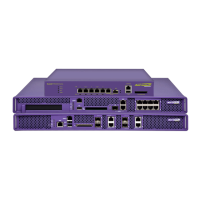Network Setup
Summit WM3000 Series Controller System Reference Guide218
architecture provides multiple forwarding links for data traffic, load balancing and therefore, reduces
the number of spanning-tree instances required to support a large number of VLANs.
Using MSTP, the network can be divided into regions. All controllers within a region use the same
VLAN to instance mapping. The entire network runs a spanning tree instance called the Common
Spanning Tree instance (CST) that interconnects regions as well as legacy (STP and RSTP) bridges. The
regions run on a local instance for each configured MSTP instance.
The network-wide spanning tree for instance 0 is known as the Common Spanning Tree (CST). A
spanning tree for any other instance, which is local to a region, is known as an Internal Spanning Tree
(IST). The Common and Internal Spanning Tree (CIST) (which consists of the CST as well as all ISTs across
regions) interconnects all bridges in the network.
The following definitions describe the STP instances that define an MSTP configuration:
● Common Spanning Tree (CST) – MSTP runs a single spanning tree instance (called the Common
Spanning Tree) that interconnects all the bridges in a network. This instance treats each region as a
single bridge. In all other ways, it operates exactly like Rapid Spanning Tree (RSTP).
● Common and Internal Spanning Trees (CIST) – CIST contains all of the ISTs and bridges not formally
configured into a region. This instance interoperates with bridges running legacy STP and RSTP
implementations.
● Multiple Spanning Tree Instance (MSTI) – The MSTI is identified by an MSTP identifier (MSTPid) value
from 1 to 15. This defines an individual instance of a spanning tree. One or more VLANs can be
assigned to an MSTI. A VLAN cannot be assigned to multiple MSTIs. The multiple spanning tree
instance 0 is always present. VLANs not explicitly assigned to an instance are assigned to instance 0.
● MSTP Region – These are clusters of bridges that run multiple instances of the MSTP protocol.
Multiple bridges detect they are in the same region by exchanging their configuration digest (which
is dependent on the VLAN to instance mapping), region name and revision-level. If you need to
have two bridges in the same region, the two bridges must have identical VLAN to instance
mappings, region names and revision-levels.
To configure the controller for MSTP support, configure the region name and the revision on each
controller being configured. This region name is unique to each region. Then create one or more
instances and assign IDs. VLANs are then assigned to instances. These instances must be configured on
controllers that interoperate with the same VLAN assignments. Port cost, priority and global parameters
can then be configured for individual ports and instances.
The Multiple Spanning Tree option contains separate tabs for the following activities:
● Configuring a Bridge
● Viewing and Configuring Bridge Instance Details
● Configuring a Port
● Viewing and Configuring Port Instance Details
Configuring a Bridge
Use the Bridge tab to configure the Bridge. This window displays bridge configuration details for the
controller.
To configure the MSTP bridge:

